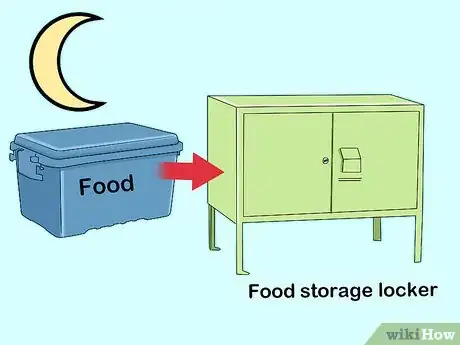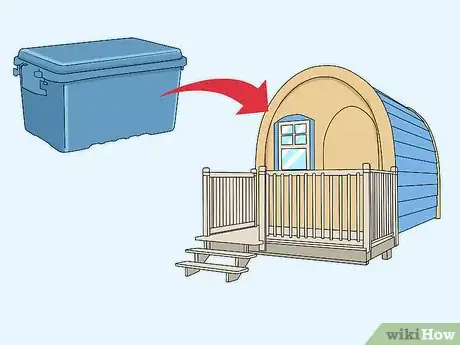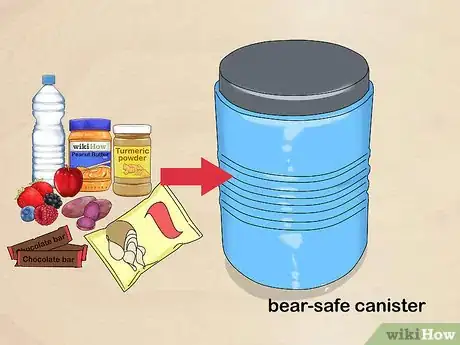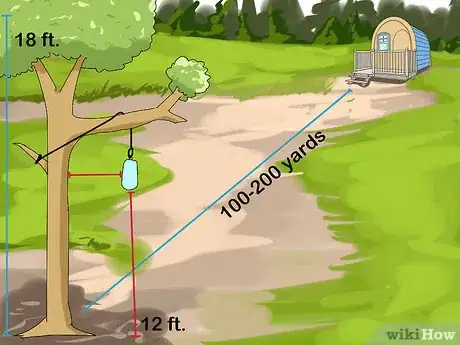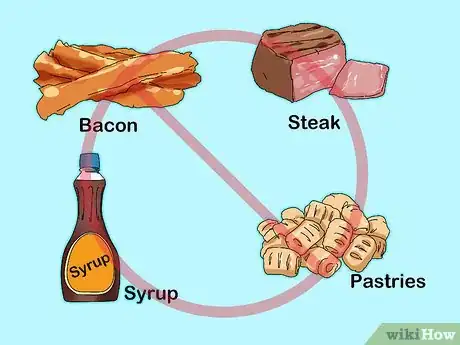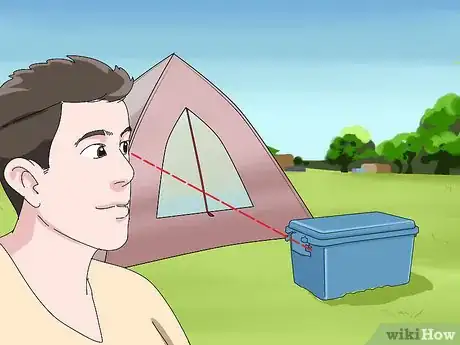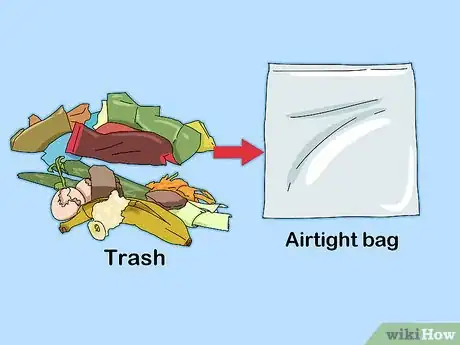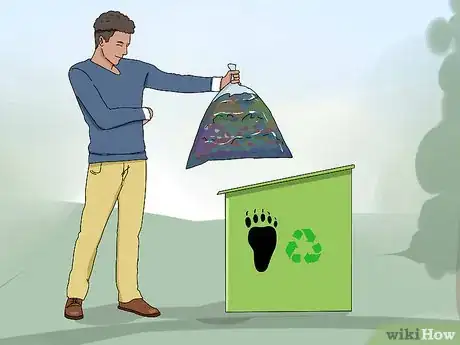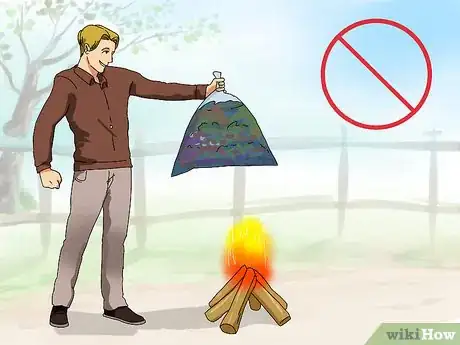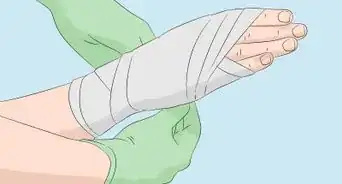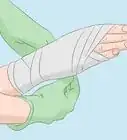This article was co-authored by High Mountain Institute. The High Mountain Institute is an educational organization dedicated to helping students connect with nature, develop as leaders, and discover education at its best. For over 25 years, HMI has taken students into the wilderness of Colorado and Patagonia and fostered communities of shared responsibility, thereby creating the foundation for rigorous intellectual experiences.
This article has been viewed 141,241 times.
Camping in bear country can be a wonderful adventure. However, you need to take precautions to protect your food from curious, hungry bears. Before you go, learn about the area. Are bears active? Is bear camping required? To what extent? If bears are active, keep your food safe using proper storage and disposal techniques. Under these circumstances, food means anything that you can put on your skin or in your mouth. This includes all food items, soap, bug repellant, medication, lip balm, canned food, deodorants, and other scented items.[1]
Steps
Storing Your Food
-
1Store your food in food lockers at night. Many campsites in bear country provide food lockers for campers to store their food in. Food lockers are typically located in parking areas near campsites. Place your food inside the locker. Make sure to secure the food locker by locking it.[2]
-
2Store your food in the car during the day, if the campsite allows it. Place the food out of sight, like under the car seat, in a cooler, or in an airtight plastic bag underneath a blanket. Make sure all of your windows are completely closed when storing your food in the car.[3]
- Do not store your food in the bed of a pickup truck, or strap it to the outside of your car.
Advertisement -
3Keep your food inside your cabin at all times. Do this if you are staying in a cabin. For extra protection, store your food in airtight plastic bags or a bear-safe canister. Because bears can break into cabins through open doors and windows, make sure to keep the cabin’s windows and doors closed and locked at all times.[4]
- You can purchase airtight plastic bags online, or from your local camping or outdoors store.
-
4Use a bear-safe canister to store your food. Bear-safe canisters are portable containers that are designed to keep food safe from bears. Put all your food items in the canister. Place the canister at least 100 feet (30 m) downwind from your campsite on flat ground. Avoid placing the canister near a water source or a cliff. Additionally, do not attach any ropes to the canister.[5]
- You can purchase bear-safe canisters online. The cost of a bear-safe canister can range from $75 to $275, depending on the size and manufacturer.
- Although campsites may rent out bear-safe canisters, their stock is limited and they may run out.
-
5Set up a bear hang. Place all of your food in a bag. Pick an area 100 to 200 yards (91 to 183 m) away from your tent. Pick a tree with a sturdy branch that is at least 18 feet (5.5 m) high. Use a bowline knot to attach a 40-foot (12-meter) rope to a carabiner. Attach the carabiner to your bag's handle. Throw the bag up and over the branch. Make sure the bag is 6 feet (1.8 m) away from the tree’s trunk.[6]
- Lower the bag toward you and loop the loose end through the carabiner. Pull the loose end to raise the bag until it is 12 feet (3.7 m) off of the ground.
- Tie the loose end around a strong twig to keep the bag in place. You may need to stand on a table to reach the bag.
- If you can't find a tree with six-foot branches, you can create a makeshift bear hang by stringing one rope between two trees, making it tight with a trucker's hitch knot, and then doing your bear hang in the middle of the rope.
EXPERT TIP"You shouldn't leave out toothpaste at night, so don't lock your canister or raise your bear bag until you have brushed your teeth!"
The High Mountain Institute is an educational organization dedicated to helping students connect with nature, develop as leaders, and discover education at its best. For over 25 years, HMI has taken students into the wilderness of Colorado and Patagonia and fostered communities of shared responsibility, thereby creating the foundation for rigorous intellectual experiences.
High Mountain Institute
Outdoor Education Non-Profit High Mountain Institute
High Mountain Institute
Outdoor Education Non-Profit
Cooking Food
-
1Only take out the food that you will be cooking. If you are cooking two eggs and two pieces of toast, for example, then only take out two eggs and two pieces of toast. Keep the food that you will not be cooking inside the food locker, cabin, or bear-safe container.[7]
- Make sure to cook your food at least 100 yards (91 m) downwind from your tent.
-
2Avoid making a mess around your kitchen or campsite. If you're cooking with foods with strong odors, try to avoid spilling grease or crumbs. Foods with strong odors like bacon, steak, syrup, pastries, and other sweets might attract bears to your campsite.[8]
-
3Cook in a designated area away from your campsite. When you first set up camp, it can be helpful to designate a space for your "kitchen," that is 100 yards away from both your campsite and any sources of water. This will keep your camp from smelling, and will also help you to avoid polluting water sources.
Hiking with Food
-
1Use a bear-safe canister or bag to transport your food. Take your food out of its packaging. Place the food in plastic airtight bags. Place these bags in a bear-safe canister. Place the canister inside of your backpack.[9]
- Alternatively, use a bear-resistant kevlar bag to store your food items while you hike.
-
2Keep your eye on your food. When you take a break to eat your food, do not set it down and wander off. Always keep your food in your line of vision and within your arm’s reach.[10]
-
3Carry your trash in airtight plastic bags. Place food wrappers and other trash in airtight, odorless bags. Place the bags in your backpack and carry them with you. Throw your trash away at the nearest bear-proof disposal unit.[11]
Disposing of Food
-
1Wash eating and cooking utensils immediately. As soon as you finish eating, fill a bucket with soap and water 100 yards (91 m) downwind from your campsite. Scrub your cooking and eating utensils thoroughly with a disposable sponge. Rinse them with clean water over the bucket. Let the cooking and eating utensils air dry. Store them in an airtight plastic bag, or a food locker.
- Throw away your dish water in an area that is at least 100 yards (91 m) downwind from your campsite.
- Make sure to throw the sponge away in a bear-proof disposal unit.
-
2Pack your trash in an airtight plastic bag. Throw the trash away in a bear-proof disposal unit. If your campsite does not have a bear-proof disposal unit, then you will need to hang your trash up high in a tree.
-
3Avoid burning trash and excess food. Campfires do not get hot enough to burn trash and excess food completely. Since bears and other wildlife are still attracted to partially burned food matter, you will only attract more bears if you dispose of your food by burning it.[12]
- Additionally, burying your food is not an effective solution either.
Community Q&A
-
QuestionWhat about medications, like blood pressure pills? Is it best to secure them with the food?
 Community AnswerNo need to store medication with your food. Keep it in a safe place close by you.
Community AnswerNo need to store medication with your food. Keep it in a safe place close by you. -
QuestionWill a campfire scare off bears?
 Tom De BackerTop AnswererNo. Though most animals are afraid of fire, scavengers such as bears have learned to associate fire to man, and man to food. Bears are apex animals, so they're not easily afraid. A fire is better than no fire to keep them at bay, though tending to it all night will prevent you from getting a good night's sleep. Lock food away in sealed containers, follow all the safety precautions for bears and other wild animals.
Tom De BackerTop AnswererNo. Though most animals are afraid of fire, scavengers such as bears have learned to associate fire to man, and man to food. Bears are apex animals, so they're not easily afraid. A fire is better than no fire to keep them at bay, though tending to it all night will prevent you from getting a good night's sleep. Lock food away in sealed containers, follow all the safety precautions for bears and other wild animals. -
QuestionI am a diabetic and must keep some sugar tablets in the tent in case of low blood sugar. Is there any way to do so safely?
 Community AnswerKeep all of your food, including the sugar tablets, in closed compartments that are air tight. Just for your safety, you may want to leave it outside your tent; that way if a bear does decide to come at least he won't attack you.
Community AnswerKeep all of your food, including the sugar tablets, in closed compartments that are air tight. Just for your safety, you may want to leave it outside your tent; that way if a bear does decide to come at least he won't attack you.
References
- ↑ https://www.nps.gov/yose/planyourvisit/bearcans.htm
- ↑ https://www.nps.gov/yose/planyourvisit/bears.htm
- ↑ https://www.nps.gov/yose/planyourvisit/bears.htm
- ↑ https://www.nps.gov/yose/planyourvisit/bears.htm
- ↑ https://www.nps.gov/yose/planyourvisit/bearcans.htm
- ↑ https://i0.wp.com/theultimatehang.com/wp-content/uploads/sites/2/2013/03/Hanging-A-Bear-Bag.png
- ↑ https://www.nps.gov/subjects/bears/storingfood.htm
- ↑ https://www.nps.gov/subjects/bears/storingfood.htm
- ↑ https://www.nps.gov/yose/planyourvisit/bearcans.htm
